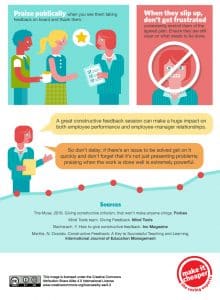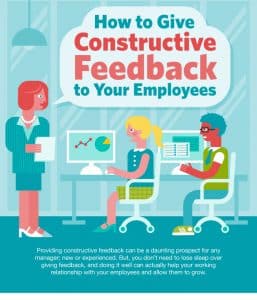Helpful Tips: How to give constructive feedback to your employees

Many are driven to excel in business by ambition, big ideas and a firm eye on success, and without such an outlook progress would rarely be made. Yet the greatest leaders are very often the ones who know how to negotiate the difficult moments, to identify problems within their team – and to guide struggling employees towards the potential for which they were originally picked out. Nobody enjoys having to tell a team member their work isn’t up to scratch or their attitude is out of line, but the way that such a situation is dealt with has an impact on the productivity of the individual, of the team and the company as a whole. Your relationship with your workforce will depend on how you help them to flourish, and the respect they have for you as boss will reflect the respect, which they are in turn shown.
When the moment comes that you must address an employee issue, you need to be prepared. You’re wasting everyone’s time if you don’t have the facts and strategies at hand that you need to make productive use of the discussion. When preparing, identify distinctly what the issue is: be task oriented, look at what isn’t getting done before you measure it up against your expectation of the employee. Only then, try to deduce what is causing the problem, and beware of you own assumptions. You may have a pretty good idea of what is going on, but there may be aspects of the situation of which you know nothing.
Next, quantify your own position. What is the cost of the issue – in both financial and human terms? If it is question of attitude or discipline, it may be that it’s the team that is suffering at the hands of the individual. If they’re public facing, perhaps you feel the company’s profile is at stake. Do you have evidence or statistics you can use to back up your argument – and motivate your team?
Constructive feedback should be a positive process, even if it’s triggered by a problem. Therefore, you need to go into the meeting calm, upbeat – and ready with solutions. Be sure to spend some of your prep time identifying the employee’s value to you, as well as specific areas on which you can compliment them. Over two-thirds of employees claim they would work harder if their work received more recognition. Think about possible solutions, but again: don’t be dogmatic. You may yet find the nature of the problem is not as you assumed, and you should be open to creating new solutions as part of the upcoming dialogue.
Before the meeting comes around, think about where it should take place. Firstly, it should be somewhere you can talk without being overheard, and preferably not watched by other team members. Even if the matter is truly urgent, it is important that you treat your employee with respect and discretion. If it’s a disciplinary matter, you’ll probably want to do it in your own office, but if it’s a more complex issue then getting out of the building for a coffee or a walk can be a creative approach to re-inspiring your employee.
Begin with some positives, but don’t beat about the bush. Chances are they know what you want to talk about, and will appreciate directness. This bold approach does not mean launching into a tirade, but rather reflecting on some of the aspects that you uncovered while you were preparing. State what the main purpose of the conversation is, and be specific without bringing anyone else’s name up. That means that even though you may be responding to a report or complaint from someone else, they don’t get mentioned: these people have to continue to work together, after all. Rather, describe in concrete terms the specifics of the situation, rather than a broader impression you have of the employee’s shortcomings. Use the statistics or evidence you prepared to help them understand the impact their performance is having on the organization, and to make it clear that your problem isn’t personal.
There comes a moment when it is time to step back and allow the employee to speak their mind. You’re trying to build a culture of creativity and co-operation, so it is important to hear their understanding of the situation, any reasons they might have for shortfalls in their performance – and any causes that could flag up deeper problems within the company.
Maybe they have personal problems, which they should not feel obliged to share with you – but if you sense there is such an undercurrent ask questions about what you can do together to improve the situation regarding the workload. This is where those strong listening skills come in. Watch out for body language, repeat back what they say to ensure you understand each other, and don’t interrupt. Given time, space, and moments of quiet, it is more likely that you will identify truths and dispel the pressure that may be inhibiting good solutions. When they open up and let you know what they feel to be the cause behind work that has suffered, offer feedback and advice that reflects your own personal experiences. We make mistakes not just so that we might learn from them, but that we can pass these lessons along to others. Often, it can help build the confidence of an employee just to let them know that it is okay to experience self-doubt or to struggle with work. Ultimately, you are on the same team and it is in everyone’s interests that the team strengthens individually and as a unit.
Indeed, this strength-in-vulnerability can be exemplified by turning the feedback 180 degrees back on yourself. Once you’ve covered the problems and causes from the employee’s point of view, open up the possibility for them to in turn offer you some feedback. Ask what there is that you could be doing to make their tasks more achievable; take this opportunity to listen to whether the team member might identify flaws in the running of the business that you might not have noticed from your position. Of course, they may be reticent to criticize, but hopefully by now you’ve already established a forum where constructive criticism is valued – and even if they don’t have the courage to offer feedback now, the possibility has been opened up for the future.
Don’t forget to thank your employee for their honesty and for making the effort to explain themselves, and explore the situation with you. In this way, you show respect and value the other person as an equal human, even if you are on different rungs of the ladder. This respect should be paid back to you, by engaging in the feedback process and by picking up their game once the session is over.
Once you’ve clarified the problems and the causes of the problems from both perspectives, it is time to build on the solutions you’ve started to identify. Be specific. Put some goals on paper: actions to be taken, targets to be reached, and processes to use. Maybe more training could form part of the solution – it can feel like a drain on resources, but applied where necessary the benefits of training can spread through the team. If your goals are quantifiable targets, be clear about what the next steps should be if there’s a problem reaching them, and be sure your employee is comfortable about the targets before you sign off on them. Make a quick recap of the meeting to ensure that you’re both on the same page, and thank them for the time and work they’ve put into the feedback process.
Hopefully you’ll both return to the floor with a sense of purpose and resolve, but remember that the feedback process doesn’t end there. Rather, this may have been the first opportunity you’ve had to open up an ongoing creative dialogue with your employee, and following up on the meeting should be a case not just of checking that the initial problem has been successfully resolved but of further developing your team dynamic and finding new challenges to which they can rise. Drop by their workspace from time to time to keep an informal eye on what’s going on, but also consider opening up an ongoing forum in the form of monthly one-to-one meetings that can be used to offer praise and assess how progress has been made from the initial feedback session. Biannual performance reviews, in which the employee’s strengths and achievements are measured against their stated role and the needs of the company, can help you develop your business roadmap together. And you know by now that regular, ongoing praise can help get the best out of your team.
For a step-by-step rundown of this process, be sure to check out this new infographic from Make It Cheaper, which breaks down the technique into the three stages described. With openness and respect, there’s no reason giving constructive feedback need be an intimidating affair – for either party.
Add CEOWORLD magazine to your Google News feed.
Follow CEOWORLD magazine headlines on: Google News, LinkedIn, Twitter, and Facebook.
This report/news/ranking/statistics has been prepared only for general guidance on matters of interest and does not constitute professional advice. You should not act upon the information contained in this publication without obtaining specific professional advice. No representation or warranty (express or implied) is given as to the accuracy or completeness of the information contained in this publication, and, to the extent permitted by law, CEOWORLD magazine does not accept or assume any liability, responsibility or duty of care for any consequences of you or anyone else acting, or refraining to act, in reliance on the information contained in this publication or for any decision based on it.
Copyright 2024 The CEOWORLD magazine. All rights reserved. This material (and any extract from it) must not be copied, redistributed or placed on any website, without CEOWORLD magazine' prior written consent. For media queries, please contact: info@ceoworld.biz
SUBSCRIBE NEWSLETTER
















